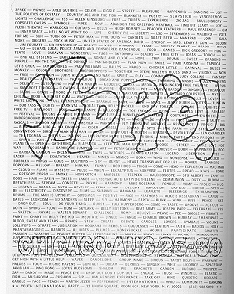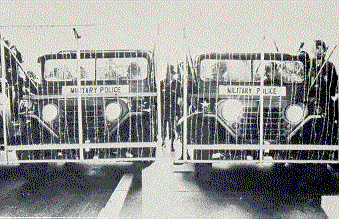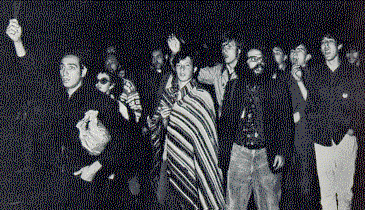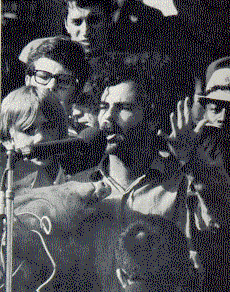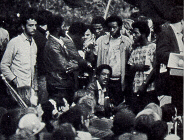What did it all mean? Was the Chicago Eight Trial merely, as one commentator suggested, "a monumental non-event"? Was it, as others argue, an important battle for the hearts and minds of the American people? Or is it best seen as a symbol of the conflicts of values that characterized the late sixties? These are some of the questions that surround one of the most unusual courtroom spectacles in American history, the 1969-70 trial of eight radicals accused of conspiring to incite a riot at the 1968 Democratic National Convention in Chicago.
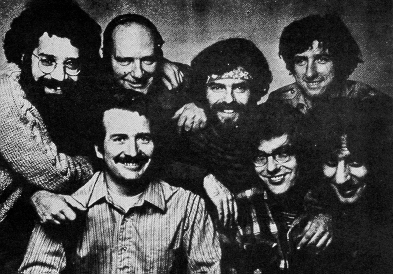
The Chicago 7 (or 8, minus Bobby Seale)
Culturally and politically, 1968 was one of the most turbulent years America has ever seen. As the Vietnam war became the longest war in U. S. history, American casualties passed the 30,000 mark. When the Viet Cong mounted their Tet offensive, anti-war protests grew larger and louder on college campuses. At Columbia, students seized the office of the President and held three persons hostage to protest the school's ties to the Defense Department. Two Jesuit priests, Phil and Daniel Berrigan, burned hundreds of draft records at a Selective Service center in Maryland. Following the April assassination of Martin Luther King in Memphis, riots erupted in 125 cities leaving 46 dead. After Senator Eugene McCarthy challenged incumbent President Lyndon Johnson over his support of the war, Johnson withdrew from the race. Senator Robert Kennedy entered the race after Johnson's withdrawal, only to be shot and killed on the night in June that he won the California primary. Hair, a controversial new musical about draftees and flower children, introduced frontal nudity to large audiences. Feminists picketed the Miss America Pageant, black students demanded Black Studies programs, and Eldridge Cleaver published Soul on Ice.
The Protests
Also in 1968, two groups met to discuss using the upcoming Democratic National Convention in Chicago to highlight their opposition to the Vietnam War and establishment values. Although there was some loose coordination between the two groups, they had different leadership, different agendas, and favored different forms of protest and demonstrations. The more politically focused of the two groups was the National Mobilization to End the War in Vietnam (MOBE). The group more focused on promoting an uninhibited lifestyle was the Youth International Party (YIPPIES). In addition to these two groups, organizations such as the Black Panther Party and the Southern Christian Leadership Conference also planned to have representatives in Chicago to press their complaints concerning racism in American policies and politics.
Rennie Davis, the national coordinator for MOBE at the time of the Convention, first announced his intentions to come to the Democratic National Convention at a meeting of a group called "The Resistance" in November, 1967, at Judd Hall at the University of Chicago. Davis told the group that he "wanted the world to know that there are thousands of young people in this country who do not want to see a rigged convention rubber-stamp another four years of Lyndon Johnson's war." Three months later the newly-formed MOBE held a planning meeting in Chicago to debate four alternative strategies for the upcoming Democratic Convention: a mass disruption strategy, a strategy of uniting behind a peace candidate such as Senator Eugene McCarthy, a "stay home" strategy, and a strategy of bringing as many anti-war people as possible to Chicago for demonstrations and teach-ins. The group of about forty, including attendees Davis and Tom Hayden, generally supported the fourth strategy. In March of 1968, MOBE sponsored another meeting, this one at Lake Villa, a YMCA Camp near Chicago, to discuss plans for August. About 200 persons, including Chicago Seven defendants David Dellinger, Rennie Davis, Tom Hayden, Abbie Hoffman, and Jerry Rubin, attended the meeting. A twenty-one page document, authored by Hayden and Davis, was distributed at the meeting. The document recommended non-violence.
Meanwhile, another group was making its own plans for Chicago. The "YIPPIES" were born, and plans for a "Festival of Life" in Chicago were first discussed in December 1967. Plans for the "Festival of Life", as they were developed by Yippie founders Abbie Hoffman and Jerry Rubin, called for a "festival of youth, music, and theater." In January, the Yippies released an initial call to come to Chicago, called "A STATEMENT FROM YIP":
"Join us in Chicago in August for an international festival of youth, music, and theater. Rise up and abandon the creeping meatball! Come all you rebels, youth spirits, rock minstrels, truth-seekers, peacock-freaks, poets, barricade-jumpers, dancers, lovers and artists!
"It is summer. It is the last week in August, and the NATIONAL DEATH PARTY meets to bless Lyndon Johnson. We
are there! There are 50,000 of us dancing in the streets, throbbing with amplifiers and harmony. We are making love in the
parks. We are reading, singing, laughing, printing newspapers, groping, and making a mock convention, and celebrating the
birth of FREE AMERICA in our own time.
"Everything will be free. Bring blankets, tents, draft-cards, body-paint, Mr. Leary's Cow, food to share, music, eager skin,
and happiness. The threats of LBJ, Mayor Daley, and J. Edgar Freako will not stop us. We are coming! We are coming from
all over the world!
"The life of the American spirit is being torn asunder by the forces of violence, decay, and the napalm-cancer fiend. We
demand the Politics of Ecstasy! We are the delicate spores of the new fierceness that will change America. We will create our
own reality, we are Free America! And we will not accept the false theater of the Death Convention.
"We will be in Chicago. Begin preparations now! Chicago is yours! Do it!"
Hoffman and Rubin continued, over the next several months leading up to the Convention, to propose ever more wild plans for the Festival of Life. Rubin announced plans to nominate a pig, Pigasus the Immortal, for President. Hoffman talked about a demonstration of public fornication, calling it a "fuck-in." A Yippie Program, distributed in August of 1968, urged Festival attendees to bring "sleeping bags, extra food, blankets, bottles of fireflies, cold cream, lots of handkerchiefs and canteens to deal with pig spray, love beads, electric toothbrushes, see-through blouses, manifestos, magazines, and tenacity." The program promised poetry readings, mass meditation, "political arousal speeches," fly casting exhibitions, rock music, and "a dawn ass-washing ceremony." There were also activities mentioned in the program that were somewhat problematic for the alleged conspirators' trial defense:
"Psychedelic long-haired mutant-jissomed peace leftists will consort with known dope fiends, spilling out onto the sidewalks in pornape disarray each afternoon....Two-hundred thirty rebel cocksmen under secret vows are on a 24-hour alert to get the pants of the daughters and wifes and kept women of the convention delegates."
At trial, Hoffman suggested that the proposal of outlandish events in the Yippie program and in speeches by Yippie leaders was simply a way of having "fun." He said that no one was expected to take the events seriously [link to Hoffman testimony].
National Guard jeeps in Chicago
Chicago officials, led by Mayor Richard Daley, saw the Democratic National Convention as a grand opportunity to promote their city to the world. They resolved not to have anti-war demonstrators spoil their plans. Pre-Convention sparring between the City and protest groups concerned the request of the Yippies to allow demonstrators to sleep in city parks. City Administrator Stahl indicated on August 5, 1968 that the request for permission to sleep in the parks would be denied and that an 11 P.M. curfew would be enforced. On August 23, officials ordered city police to post signs in parks announcing the curfew. As the Convention opening approached, Daley put the city's 12,000 police officers on twelve-hour shifts. In addition, 7,500 Army troops and 6,000 national guardsmen, requested by Daley to aid in keeping order, arrived in Chicago.
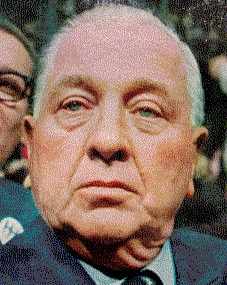
Mayor Richard Daley
In late August, mostly student-aged anti-war and counter-culture activists began arriving in Chicago. Several thousand would eventually participate in the Convention week protests (a number far below the 100,000-person estimate that some organizers had predicted). Several days before the convention, demonstration leaders began holding classes in Lincoln Park on karate, snake dancing, and other means of self-defense. Preparations were woefully inadequate for the level of police violence that demonstrators would face. On Friday, August 23, MOBE learned that a federal district judge had denied their request for an injunction that would have forced the city to allow use of the parks after 11 P. M.
Allan Ginsberg (with beard) in Lincoln Park
The next day radical leaders held a contentious meeting to discuss whether demonstrators should abide by the city's curfew. Among those favoring compliance with the curfew was Jerry Rubin; among those urging violation of the curfew was Abbie Hoffman. The first significant confrontations between demonstrators and protesters occurred that night. Some people were tear-gassed. A more serious confrontation with police was avoided when poet Allen Ginsberg led demonstrators out of Lincoln Park "Om-ing" (chanting "Ommmmmm").
Jerry Rubin with a pig
Sunday, August 25 was to be the much heralded "Festival of Life" featuring rock music and Yippie revelry. Only the band MC5 showed up, but even they were reluctant to perform. They feared that police would destroy their sound system. The young people who gathered in the park on Sunday evening handed out flowers, smoked pot, made out, and listened to poetry. About 10:30, a police officer with a bullhorn walked through the park saying, "The park is closing. If you stay in the park, you'll be arrested." Some young people, most of them local "greasers" rather than out-of-town protesters, threw objects at a police car. At 11 P. M., police charged into the people still in the park, tear gassing them and hitting them with billy clubs. The clearing of the park continued for hours. Some kids ran around smashing car windows and vandalizing buildings.
Police cracked more heads and fired more tear-gas grenades again the next night. They attacked about 3,000 demonstrators gathered in the southeastern corner of Lincoln Park shortly after the 11 P. M. curfew. Testifying later about that night, Robert Pierson, an undercover officer working as Hoffman's bodyguard, said that the Yippie leader announced, "We're going to hold the park. We're going to fuck up the pigs and the Convention." Shortly after midnight, Tom Hayden became the first of the alleged conspirators to be arrested. An officer spotted Hayden letting the air out of the tires of a police car. A half hour later, Rennie Davis (according to a prosecution undercover witness) stood at the barricades in Lincoln Park with a megaphone shouting at people to "fight the pigs."
Bobby Seale in Lincoln Park
August 27 was another wild day in Chicago. It began with a sunrise service of chants, prayers, and meditation in Lincoln Park, led by Allen Ginsberg. Bobby Seale arrived in Chicago and addressed a crowd of about 2,000 in Lincoln Park. His speech, advocating a violent response to police, was later made the basis for charging him with a violation of the 1968 Anti-Riot Act. Abbie Hoffman, furious with MOBE for its continued advocacy of non-violence, allegedly met with the Blackstone Rangers to persuade them to come to the park with weapons that night. In the Chicago Coliseum, about 4,000 persons gathered to hear David Dellinger, folk singer Phil Ochs, novelist William Burroughs and a variety of other peace movement celebrities. Shortly after 11 P. M., the nightly routine of clubbing and tear gassing repeated in the park. Some enraged demonstrators smashed windows and streetlights.
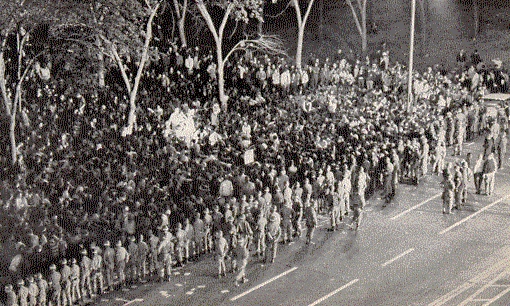
Demonstrators mass along Michigan Avenue
Convention week violence peaked on Wednesday, August 28. The day began with Abbie Hoffman being arrested while having breakfast and charged with public indecency for having written the word "Fuck" on his forehead. (Hoffman said he did so to discourage the press from photographing him.) In the afternoon, Dellinger, Seale, Davis, and Hayden addressed 10,000 to 15,000 demonstrators at the band shell in Grant Park, opposite the Convention's headquarters hotel, the Conrad Hilton. Tom Hayden allegedly told the audience: "Make sure that if blood is going to flow, let it flow all over the city. If we're going to be disrupted and violated, let the whole stinking city be disrupted. I'll see you in the streets!" Around 3 P.M., some people in the crowd lowered an American flag from a flagpole and attempted to raise a red flag in its place. When the police moved in to retrieve the American flag, Jerry Rubin yelled "Kill the pigs! Kill the cops!" In another incident, Rennie Davis was clubbed into unconsciousness, taken to a hospital, then covered with a sheet and moved from room to room in a successful effort to foil police who planned to arrest Davis during a search of the hospital. That evening, in the Chicago Amphitheatre, Democrats nominated Hubert Humphrey as their candidate for President. Police stopped a nighttime march of about 1,500 people to the Amphitheatre. They attacked demonstrators with tear gas and clubs at numerous street intersections in the area.
The clubbing and the tear gassing finally let up on Thursday, but protest activities continued. Senator Eugene McCarthy and comedian Dick Gregory were among those who addressed a crowd in Grant Park. Police undercover officer Irwin Bock met in the park with John Froines and Lee Weiner. Froines allegedly said that the demonstrators needed more ammunition to use against police. Weiner reportedly then suggested Molotov cocktails, adding that a good tactic might be to pick a target in the Loop and bomb it. Weiner told Bock and others to get the bottles, sand, rags, and gasoline necessary to make the Molotov cocktails.
The Trial
Until enactment of the 1968 Civil Rights Act, rioting and incitement to riot was a strictly local law enforcement issue. Congress, however, felt compelled to respond to the ever-increasing numbers of anti-war protests around the country. The new law made it a federal crime to cross state lines with the intent to incite a riot. Even after passage of the law, Attorney General Ramsey Clark and the Justice Department were reluctant to enforce the new provisions. Clark viewed what had happened in Chicago as primarily a police riot. The Attorney General expressed more interest in prosecuting police officers for brutality than in prosecuting demonstrators for rioting.
The Justice Department's lack of interest in prosecuting protest leaders outraged Chicago Mayor Richard Daley. Daley convinced a close friend and federal judge, William Campbell, to summon a grand jury to consider possible violations of the anti-riot law. On March 20, 1969, the jury returned indictments against eight demonstrators, balanced exactly by indictments against eight police officers. The eight indicted demonstrators included Abbie Hoffman, Jerry Rubin, David Dellinger, Tom Hayden, Rennie Davis, John Froines, Lee Weiner, and Bobby Seale. By the time the grand jury returned its indictments, the Nixon Administration had begun. The new attorney general, John Mitchell, exhibited none of his predecessor's reluctance about prosecuting demonstrators. Mitchell gave the green light to prosecute.
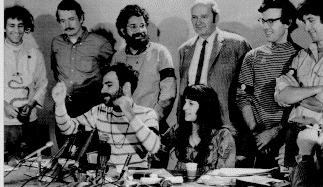
On September 24, 1969, thirteen months after the riots that shocked America, the trial of the so-called "Chicago Eight" began in the oak-paneled, twenty-third-floor courtroom of Judge Julius Hoffman. The 300 members of the panel of potential jurors were overwhelmingly white, middle-class and middle-aged. They reminded author and trial observer J. Anthony Lukas of "the Rolling Meadows Bowling League lost on their way to the lanes." Defense attorneys William Kunstler and Leonard Weinglass submitted to Judge Hoffman a list of fifty-four proposed questions for potential jurors. They believed that the questions might aid them in their use of juror challenges by revealing cultural biases. Among the questions the defense attorneys wanted to ask jurors were: "Do you know who Janis Joplin and Jimi Hendrix are?", "Would you let your son or daughter marry a Yippie?", and "If your children are female, do they wear brassieres all the time?" Judge Hoffman rejected all but one of the proposed questions, asking the jurors only "Are you, or do you have any close friends or relatives who are employed by any law enforcement agencies?" (Later, the Seventh Circuit Court of Appeals would cite the judge's refusal to allow inquiry into the potential cultural biases of jurors as a ground for reversing all convictions.) Three hours after voir dire began, a jury of two white men and ten women, two black and eight white, was seated. It was clearly not a good jury for the defense. (After the trial, one female juror commented that the defendants "should be convicted for their appearance, their language and their lifestyle." Edward Kratzke, the jury foreman, also was angered by the defendants' courtroom behavior: "These defendants wouldn't even stand up when the judge walked in; when there is no more respect we might as well give up the United States." A third juror expressed the view that the demonstrators "should have been shot down by the police.")
The defense and prosecution tables stood in dramatic contrast. At the defense table, defendants relaxed in blue jeans and sweatshirts, often with their feet up on chairs or the table itself. Hoffman and Rubin favored attire that included headbands, buttons, beads, and colorful shirts. The defendants passed trial hours munching jelly beans, cracking jokes, offering editorial comments, making faces, reading newspapers, and sleeping. The area around the defense table was littered with clothing, candy wrappers, and even (on one day) a package of marijuana. The prosecution table, behind which sat silver-haired District Attorney Thomas Foran and his young assistant Richard Schultz in their business suits, was, on the other hand, a picture of neatness and efficiency. The prosecution table was clear of all but carefully arranged notes, a file of index cards, and a pencil.
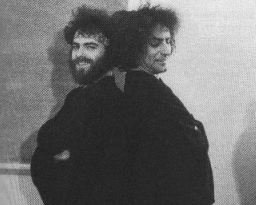
Rubin and Hoffman in judicial robes
There was division in the defense ranks concerning trial strategy. Some of the defendants, such as Tom Hayden, wanted to play the trial straight: to concentrate on winning jurors by diligently pursuing weaknesses in the prosecution's case and by observing a degree of courtroom decorum. Others, such as Jerry Rubin and Abbie Hoffman, saw the trial as an opportunity to appeal to young people around the country. [Link to interview with Hoffman about trial.] They wanted to turn the trial into entertaining theater that would receive maximum attention in the press. To that end, the Yippies would spice up the days of the trial by, for example, wearing judicial robes, bringing into the courtroom a birthday cake, blowing kisses to the jury, baring their chests, or placing the flag of the National Liberation Front on the defense table.
In his trial account The Barnyard Epithet an Other Obscenities, J. Anthony Lukas divides the Chicago Conspiracy Trial into five "phases." The first period, which Lukas calls "The Jelly Bean Phase," lasted from September 24 to October 13. It was a relatively uneventful stage, in which the defendants took a "gently mocking" stance toward the trial. The second period, the "Gags and Shackles Phase," lasted from October 14 to November 5. This phase by the defendants sought to emphasize political issues in the trial, perhaps because they were concerned that the trial was being seen by their sympathizers as a mere joke. Also during this phase, Black Panther defendant Bobby Seale continuously, and in increasingly angry tones, insisted upon his right either to represent himself or to have the trial continued until his own counsel of choice, Charles Garry (who was hospitalized for gall bladder surgery), could represent him. Seale hurled frequent and bitter attacks at Judge Hoffman, calling him a "fascist dog," a "pig," and a "racist," among other things. On October 29, the outraged judge ordered Seale bound and gagged. Finally, on November 5, Hoffman severed Seale from the case and sentenced him to four years in prison for contempt. The Chicago Eight suddenly became the Chicago Seven. Phase three, lasting from November 6 to December 10, was called by Lukas "Government's Day in Court." It was a relatively calm period with only nine contempts, as the defendants saw in a surprisingly weak prosecution case the opportunity for at least a hung jury if they could "cool it" and avoid turning the jury against them. Phase four, from December 11 to January 22 was the "Sing Along with Phil and Judy Phase." This was the phase in which the defense presented its witnesses, a virtual "who's who" of the American left from the guru of the drug culture Timothy Leary to radical poet Allen Ginsberg to folk singers Phil Ochs, Arlo Guthrie, "Country Joe" McDonald, Pete Seeger and Judy Collins. The final phase of the trial, from January 23 to February 7, Lukas called the "Barnyard Epithet Phase." It was a two-week period marked by increasingly bitter outbursts by the defendants and their attorneys, and by almost irrational overreactions by Judge Hoffman. Forty-eight contempts came in this shortest of the five trial phases.

The heart of the government's case was presented through the testimony of three undercover agents who had infiltrated radical ranks, Irwin Bock, William Frappolly, and Robert Pierson. Pierson landed a job as Rubin's "bodyguard," while Bock and Frappolly maneuvered their way into leadership positions in "Vets for Peace" and the S. D. S. (Students for a Democratic Society). The undercover witnesses described plots to disrupt traffic, takeover hotels, "sabotage" restrooms, and other "hit-and-run guerilla tactics." The government's case was aided substantially by Judge Hoffman who consistently ruled in favor of the prosecution on evidentiary disputes. For example, Hoffman allowed the government to introduce speeches of the defendants made well before their arrival in Chicago when they tended to support the government's case, but ruled that the defense could not introduce (because they were "self-serving") pre-Convention documents that suggested peaceable intentions. Throughout the presentation of the government's case, Thomas Foran played the straight man, while his younger associate, Richard Shultz, expressed outrage at defense behavior and--whenever the opportunity arose--went for the jugular. J. Anthony Lukas marveled that "Shultz could have made the first robin of spring sound like a plot by the Audubon Society."
The defense through its witnesses tried to portray the defendants as committed idealists who reacted spontaneously to escalating police violence. It suggested that what the prosecution saw as dangerous plots, such as an alleged Yippie conspiracy to place LSD in the Chicago water supply, were only play. The defense also attempted, without much success because of Judge Hoffman's rulings excluding such testimony, to make the Viet Nam War an issue in the trial. The defense countered the prosecution's attempt to prove a conspiracy with evidence that the alleged conspirators never met as a group--and would have agreed upon little if they had. Defense witness Norman Mailer probably made the point best when he said, "Left-wingers are incapable of conspiracy because they're all egomaniacs." Abbie Hoffman made the same point more colorfully when he said, "Conspiracy? Hell, we couldn't agree on lunch."
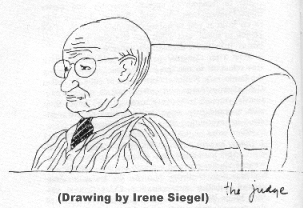
Judge Julius Hoffman
The jury had scarcely begun its deliberations in the Chicago Conspiracy Trial when Judge Hoffman began sentencing each of the defendants and the two defense attorneys, William Kunstler and Leonard Weinglass, to lengthy prison terms on 159 specifications for criminal contempt. The specifications ranged from minor acts of disrespect (such as not standing for the judge) to playful acts (such as baring rib cages or blowing kisses to the jury) to insulting or questioning the integrity of the court ("liar," "hypocrite," and "fascist dog"). William Kunstler, who seemingly became a radicalized brother of his clients over the course of the trial, was sentenced by Hoffman to four years and thirteen days in jail. One specification for Kunstler concerned an incident on February 3 when he said "I am going to turn back to my seat with the realization that everything I have learned throughout my life has come to naught, that there is no meaning in this court, there is no law in this court." The Seventh Circuit Court of Appeals later reversed all contempt convictions, ruling that contempt convictions resulting in more than six months in prison require jury trials.
The jury initially split, with eight jurors voting to convict defendants on both the conspiracy and intent to incite riot charges and four jurors voting to acquit on all charges. Foreman Edward Kratzke handed a hung-jury message to the marshal to take to Judge Hoffman. The judge's response: "Keep deliberating!" Juror Kay Richards finally brokered a compromise between the two jury factions. In the end, jurors acquitted all defendants on the conspiracy charge, while finding the five defendants charged with having an intent to incite a riot while crossing state lines guilty. The jury acquitted Froines and Weiner of the charge of teaching and demonstrating the use of an incendiary device.
On February 20, 1970, Judge Hoffman sentenced the five members of the Chicago Seven found guilty by the jury. Each defendant made a statement before sentence was imposed. David Dellinger told Hoffman that he was "a man who had too much power over too many people for too many years," but that he admired his "spunk." Rennie Davis announced that when he got out of prison he intended to "move next door to [prosecutor] Tom Foran, and bring his sons and daughter into the revolution." Tom Hayden offered the opinion that "we would hardly have been notorious characters if they left us alone on the streets of Chicago," but instead "we became the architects, the masterminds, and the geniuses of a conspiracy to overthrow the government-- we were invented." Abbie Hoffman recommended that the judge try LSD: "I know a good dealer in Florida [where the judge was soon to head for a vacation]; I could fix you up." Jerry Rubin offered the judge a copy of his new book Do It! with an inscription inside: "Julius, you radicalized more young people than we ever could. You're the country's top Yippie." After listening to each defendant give his statement, Judge Hoffman sentenced each defendant to five years' imprisonment plus a $5,000 fine.
The Seventh Circuit Court of Appeals reversed all convictions on November 21, 1972. The appellate court based its decision on the refusal to allow inquiry into the cultural biases of potential jurors during voir dire as well as Judge Hoffman's "deprecatory and often antagonistic attitude toward the defense." The court also noted that it was determined after appellate argument that the F. B. I, with the knowledge and complicity of Judge Hoffman and prosecutors, had bugged the offices of the Chicago defense attorneys. The Court of Appeals panel said that it had "little doubt but that the wrongdoing of F. B. I. agents would have required reversal of the convictions on the substantive charges."

Hoffman, Dellinger and Seale in Chicago twenty years after their trial
All seven Chicago police officers charged with violating the civil rights of demonstrators were acquitted. Charges against an eighth officer were dismissed. Richard Shultz explained the verdicts by observing, "The people who sit on juries in this city are just not ready to convict a Chicago policeman."
There is no simple "yes" or "no" answer to the question of whether the Chicago defendants intended to incite a riot in Chicago in 1968. Abbie Hoffman said, "I don't know whether I'm innocent or I'm guilty." The reason for the confusion--as Norman Mailer pointed out--was that the alleged conspirators "understood that you didn't have to attack the fortress anymore." All they had to do was "surround it, make faces at the people inside and let them have nervous breakdowns and destroy themselves."

